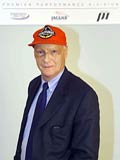![]()

|
Primary sponsors
Chassis
Engine
Transmission
Front Suspension
Rear Suspension
Front Brakes
Rear Brakes
Wheels
Tyres
Electronics
Niki Lauda has one of the most famous names and faces in the world of Formula One. A legacy not only of his horrific fiery crash in the 1976 German Grand Prix, but also of his success as a driver and businessman. He won two world championships in the 1970's, retired from racing to set up his own airline, and then returned to the cockpit to capture a third title. Lauda comes from a wealthy Viennese background, and traded on his family name to secure loans that allowed him to go racing against his father's wishes. He made his F1 debut at his home GP in 1971 at the wheel of a March, and drove a full season with the team the following year. For 1973 he moved to BRM, and for the first time in his racing career was paid to drive rather than vice versa. In uncompetitive machinery he produced impressive performances and was snapped up by Ferrari for the 1974 campaign. His first win came three races into his Ferrari career, and he went on to finish fourth in the championship. It all went right for the Austrian the following season, and he took five wins on his way to the title. He looked set to repeat his success in 1976, when he crashed with near fatal consequences at the daunting Nurburgring. Miraculously he was back in action after missing just two races, and went into the final round of the championship with a slender points lead. His brave decision to withdraw from the race due to dangerous wet conditions handed the title to James Hunt, but Lauda regained his crown in 1977. He left Ferrari for Brabham, but became disillusioned with F1 and retired midway through 1979 to set up LaudaAir. However, three years later he was back in F1 with McLaren. Two wins came during his comeback season, and in 1984 he took his third world championship by the narrowest of margins, half a point. At the end of the 1985 season Lauda retired from F1 for the second time. He built his airline into a serious international operation, and in 1992 he returned to Ferrari to act as a consultant. He left the team and F1 again five years later. LaudaAir was taken over by Austrian Airlines in 2001 and Niki returned to motor racing as head of Fordís Premier Performance Division. A shrewd operator, who doesn't suffer fools, Lauda has been charged with coordinating the activities of Cosworth Racing, Pi and Jaguar Racing, to produce an outfit ready to challenge for the world championship.
Career History:
Mar 1972 - May 1976:
May 1976 - Oct 1980:
Oct 1980 - Dec 1989:
Jan 1990 - May 1992:
May 1992 - Dec 1992:
Oct 1993 - Dec 1994:
July 1995-2000: December 2000: Joins Jaguar as Technical Director "Modern F1 is a big undertaking, Twenty years ago you could have a single 'star' designer who could do it all himself, with a couple of draftsmen and a technician or two. You can't do that anymore. You have to co-ordinate the activities of a large number of good people. I like to work like that; I like to get together a group of people that are very good technically, and get them to work as a team and gel together". "The ideal situation is where everyone puts the benefit of the team first. What I try to convey to people is that if you put the team first and put yourself second, then as the team is successful your own personal success follows. I like to have a group of young engineers and it pleases me to see them achieve success." The relationship that Steve has already begun to forge with Russell and Handford will be key to the team's progress. "It will take time but they are good guys. I think we are all on the same wavelength. All three of us really want to get on with the job, get on well and work together. We want to get the maximum contribution from everybody. We need a competitive spirit. I want the engineers to want to beat the other engineers in the same way that the drivers want to beat the other drivers." Click on the thumbnail to view the image in full size
The official Jaguar web site
|
|
[ Home |
Magazine |
News |
Grapevine |
Photo Gallery |
|
© 1995-2005 Kaizar.Com, Inc.
Copyright & Terms
 Team Principal - Niki Lauda
Team Principal - Niki Lauda
 Technical Director - Steve Nichols
Technical Director - Steve Nichols

